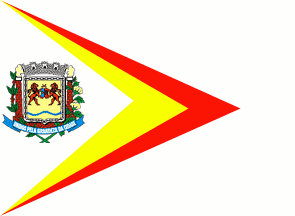 image by Dirk Schönberger,
29 October 2012
image by Dirk Schönberger,
29 October 2012Source: http://www.fernandopolis.sp.gov.br/Portal/Principal.asp?ID=158

Last modified: 2012-11-04 by ian macdonald
Keywords: sao paulo | fernandópolis |
Links: FOTW homepage |
search |
disclaimer and copyright |
write us |
mirrors
 image by Dirk Schönberger,
29 October 2012
image by Dirk Schönberger,
29 October 2012
Source:
http://www.fernandopolis.sp.gov.br/Portal/Principal.asp?ID=158
A white flag, with a red triangle, overlain by a yellow triangle, overlain by a white triangle, all extending from the hoist, and bearing the municipal arms on the white triangle.
A flag with a silver background was found on Wikimedia commons at http://upload.wikimedia.org/wikipedia/commons/8/8d/Bandeirafern.jpg but this is possibly wrong.
Official website at
http://www.fernandopolis.sp.gov.br
Dirk Schönberger,
29 October 2012
Fernandópolis was established as the merger of Villa Brasilândia, founded in 1938 by Carlos Barozzi, and Villa Pereira, founded in 1939 by Joaquim Antônio Pereira. In 1943, Fernando Costa, Federal Mediator of the State of São Paulo, convinced the two rival towns to unite in a single one, which was named for him. The Municipality of Fernandópolis was established on 30 November 1944 by State Decree-Law No. 14,334, seceding from the municipalities of Tanabi and Pereira Barreto. With its seat in Pereira, the municipality was inaugurated on 1 January 1945. The municipal territory subsequently decreased following the emancipation of several municipalities: Jales (State Law No. 233, 24 December 1948), Indiaporã (State Law No. 2,456, 30 December 1953), Guarani d'Oeste and Meridiano (State Law No. 5,285, 18 February 1959), and Macedônia and Pedranópolis (State Law No. 8,092, 28 February 1964). The municipality is made today of the Districts of Fernandópolis (seat) and Brasitânia.
The flag is shown on the official site at http://www.fernandopolis.sp.gov.br/Portal/Principal.asp?ID=158. The silver background was found on Wikimedia commons at http://upload.wikimedia.org/wikipedia/commons/8/8d/Bandeirafern.jpg but this is possibly wrong.
Searching for additional sources, especially photos, often helps in solving such issues.
The background of the flag is white, not grey, as shown by several photos. The flag of Fernandópolis is white with two yellow and red chevrons and the municipal coat of arms placed near the hoist.
Photos:
http://www.flickr.com/photos/robsonleandro/7383395036
http://quintopress10.blogspot.fr/2011/05/fernandopolis-ja-tem-agenda.html
http://www.cidadaonet.com.br/?pg=noticias-conteudo&id=1901
http://blog.fernandopolis.net/?p=32
http://www.flickr.com/photos/leandrosano/4455613539
The coat of arms of Fernandópolis is prescribed by Municipal Law No. 11 of 5 April 1965. "Samnitic shield surmounted by an eight-towered mural crown argent. Or; two lions affronty gules holding an escutcheon, per pale azure a St. Catherine's wheel or, gules six 'costelas" argent per pale. In base a narrow fess wavy azure. A bordure argent charged with a chain sable. The shield placed in front of two smoking chimneys, surrounded dexter by a branch of coffee fructed proper and dexter by a branch of flowered cotton. Below the shield a scroll azure inscribed the motto 'UNIDOS PELA LA GRANDEZA DA CIDADE' (United for the Greatness of the Town) in letters or".
The Samnitic shield, of French origin, was the first style of shield introduced to Portugal. Accordingly, it is used to evoke the Latin origin of the place and the legacy of Portuguese heraldry. The eight- towered mural crown represents a second-rank town, seat of a "comarca". Or is the heraldic symbol of nobleness, wealth, splendor, glory, power and force (according to Guelfi), synthesizing the goals that the people of Fernandópolis will attain through continuous and efficient work. The two lions holding the escutcheon of arms of the Costa family represent the union of the inhabitants of Vila Brasilándia e Vila Pereira, who, under the meditation of Fernando Costa, formed the town named for the mediator. Gules (red) means intrepidity, courage, and valiance, which characterize the pioneers who founded the two towns. The blue wave represents brook Santa Rita, which has its source close to the municipal seat and forms the border with the municipality of Estrela d'Oeste. The bordure argent represents liberty and emancipation, as well as concord and loyalty. Sable (black) symbolizes prudence, wisdom, honesty, firmness and obedience, characteristic of the inhabitants of the two towns who manage the municipality with honesty and wisdom. Argent is the heraldic symbol of friendship, equity, justice, innocence and purity, inspired by the Christian faith to a new order and cherishing peace. The chimneys symbolize industry, especially ceramics, which significantly contributes to the growth of the municipality. Coffee and cotton represent the products of the fertile soil, another component of the municipal economy. The motto is an affirmation of faith, summarizing the coat of arms and emphasizing the value of the inhabitants of the municipality.
http://www.fernandopolis.sp.gov.br/Portal/Principal.asp?ID=171 - Municipal website
Ivan Sache, 1 November 2012